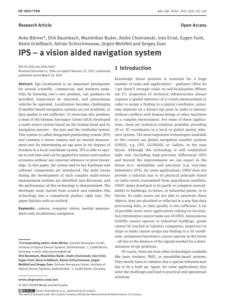Studies of ROV concepts 2015 - 2017





Date of publication: 2016
Authors: Ali Jebelli, M. C.E. Yagoub, B. S. Dhillon.
Abstract:
Underwater robots design involves critical control issues
due to complex non-linear forces. In this paper, a robust
approach was proposed to efficiently control the behavior
of an underwater robot through five degrees of freedom,
also by designing a new type of thruster with the ability of
360 degrees rotation along with a mass shifter. That gives
the possibility to easily change the machine depth,
preserving its balance and saving energy.

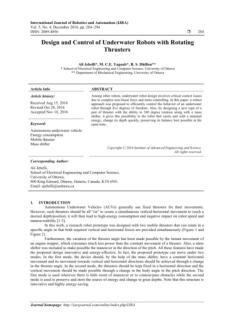

Date of publication: 2015
Authors:
Mohd Shahrieel Mohd Aras, Fadilah Abdul Azis, Syed
Mohamad Shazali Syed Abdul Hamid, Saiful Edwend
Daswir, Fara Ashikin Ali.
The major obstacle faced by the underwater environment
system is the extreme loss of color and contrast when
submerged to any significant depth whereby the image
quality produced is low. The studies can be easily done by
developing a prototype that may imitate the underwater
environment.



Date of publication: 2017
Author: Syed Mohamad Shazali
Abstract:
This paper presents research to illustrate the
hydrodynamic force impact on the orientation of a
Remotely Operated Underwater Vehicle (ROV) operating
underwater by providing kinaesthetic haptic feedback to
its handheld steering device. A literature review was done
on the haptic feedback available to ROV pilots and how it
could be delivered through a handheld device to
understand how this aim can be achieved.



Date of publication: 2017
Authors:
Mohd Shahrieel Mohd Aras, Muhammad Nizam
Kamarudin, Iktisyam Zainal, Mohd Khairi Mohd
Zambri & Marizan Sulaiman.
Abstract:
This paper presents an integrated sensor system to be
applied in underwater vehicles based on 5-DOF Inertial
Measurement Unit (IMU) sensor, MPX pressure sensor,
and temperature sensor.



Date of publication: 2015
Authors: DNV
Scope:
These rules are valid for the construction of remotely
operated vehicles (ROV) which shall be classified
by the Society, including their operating and monitoring
systems.
Unmanned underwater vehicles (UUV) may be (ROV) or
autonomous underwater vehicles (AUV).



Date of publication: 2017
Authors:
Angelo Odetti, Giorgio Bruzzone, Massimo Caccia,
Edoardo Spirandelli, & Gabriele Bruzzone
Abstract:
P2-ROV is a portable polar ROV. Designed to be
transported via-helicopter and easily handled by a small
team of scientists it is specially addressed to work under
the shelf ice of Antarctica by
exploiting the holes drilled in the ice by means of a special
350 mm auger; the shape of the vehicle reminds that of a
torpedo contained in a 340 mm diameter.



Date of publication: 2017
Authors:
Alin Ghilezan, Mihaela Hnatiuc.
Abstract:
The opportunity for the future engineers for direct hands-
on work in projects and the liberty of trying their solutions
and to apply personal ideas with a large variety of
electronic components, it will lead to a progress in
everyday life for the future generations. In this paper we
present a remote controlled ROV (Remotely Operated
Vehicle) based on Arduino Mega 2560 microcontroller
which acquired the sensors data and controls the
direction and acceleration.



Authors:
Houssam Albitar, Kinan Dandan, Anani Ananiev, and Ivan
Kalaykov.
Underwater robots are being developed for various
applications ranging from inspection to maintenance and
cleaning of submerged surfaces and constructions. These
platforms should be able to travel on these surfaces.
Furthermore, these platforms should adapt and
reconfigure for underwater environment conditions and
be autonomous. Regarding the adhesion to the surface,
they should produce a proper attaching force using
lightweight technics.



Authors:
Yaoyao Wang, Surong Jiang, Fei Yan, Linyi Gu, and Bai
Chen
A new redundancy resolution method is proposed and
investigated for motion coordination problems between
the underwater vehicle and the manipulator of the
underwater vehicle–manipulator system. The proposed
method mainly has two parts: a fuzzy logic part and a
multitasks weighted gradient projection method part.



Authors:
Yang Luo, Jianguo Tao, Hao Sun, Zhuang Hao, Hao Li,
Qiang Na, Haibo Gao, Liang Ding, and Zongquan Deng.
This article explains a novel localization approach
incorporating attitude and heading reference systems and
underwater altimeters that accurately localize the
underwater welding vehicles in spent fuel pools of the
nuclear power stations. Different from the conventional
underwater localization technologies, the presented
localization approach is more suitable in cases of confined
structured water areas.



Authors: Wei Peng Lin, Cheng Siong Chin, Leonard
Chin Wai Looi, Jun Jie Lim, and Elvin Min Ee
Teh.
Control systems prototyping is usually constrained by
model complexity, embedded system configurations, and
interface testing. The proposed control system prototyping
of a remotely-operated vehicle (ROV) with a docking
hoop (DH) to recover an autonomous underwater
vehicle (AUV) named AUVDH using a combination of
software tools allows the prototyping process to be
unified. This process provides systematic design from
mechanical, hydrodynamics, dynamics modeling, control
system design, and simulation to testing in water.



Authors: Josep Bosch, Pere Ridao, Rafael Garcia and
Nuno Gracias
The use of omnidirectional cameras underwater is
enabling many new and exciting applications in multiple
fields. Among them, it will allow Remotely Operated
Underwater Vehicles (ROVs) to be piloted directly by
means of the images captured by omnidirectional
cameras through virtual reality (VR) headsets. This
immersive experience will extend the pilot’s spatial
awareness and reduce the usual orientation problems
during missions. This paper presents this concept and
illustrates it with the first experiments for achieving this
purpose.

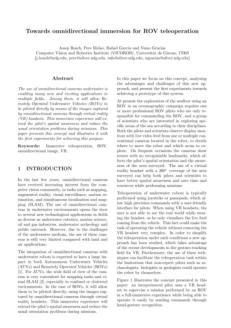

Authors:
Christian Katlein, Martin Schiller, Hans J. Belter, Veronica
Coppolaro, David Wenslandt, and Marcel Nicolaus
To increase the observational capabilities of sea ice
scientists, the authors equipped a remotely operated
vehicle (ROV) as sensor platform for interdisciplinary
research at the ice water interface. This document
presents the technical details and operation scheme of the
new vehicle and provide data examples from a first
campaign in the Arctic in autumn 2016 to demonstrate
the vehicle’s capabilities.



Authors: Francesca Tramacere, Nicola M. Pugno,
Michael J. Kuba and Barbara Mazzolai
The attachment mechanism of the octopus's sucker has
attracted the interest of scientists from different research
areas, including biology, engineering, medicine, and
robotics. From a technological perspective, the main goal
is to identify the underlying mechanisms involved in
sucker attachment for use in the development of new
generations of artificial devices and materials. Recently, the
understanding of the morphology of the sucker has
significantly improved; however, the mechanisms that
allow attachment remain largely unknown. This work
presents new anatomical findings.



Date of publication: 2015
Authors: Auke Jan Ijspeert, Alessandro Crespi, Dimitri
Ryczko, Jean-Marie Cabelguen
The transition from aquatic to terrestrial locomotion was a
key development in vertebrate evolution.
The authors present a spinal cord model and its
implementation in an amphibious salamander robot,
demonstrating how a primitive neural circuit for
swimming can be extended. The model suggests neural
mechanisms for the modulation of velocity, direction, and
type of gait that are relevant for all tetrapods.



Date of publication: 2015
Authors: Mehdi Zare Ernani, Mohammad Bozorg, and
Saeed Ebrahimi
In designing an underwater vehicle or robot, its
maneuverability and controllability must be simulated and
tested before the product is finalized for manufacturing.
Since the hydrodynamic forces and moments highly affect
the dynamic and maneuverability of the system, they must
be estimated with reasonable accuracy. This study
identifies hydrodynamic coefficients of an autonomous
underwater vehicle (AUV) using velocity and
displacement measurements and implementing an
Extended Kalman Filter (EKF) estimator.

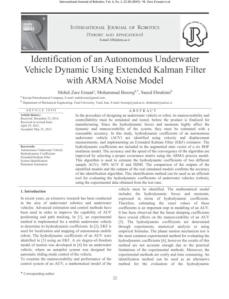

Date of publication: 2015
Authors: S.A.T. Randeni, Z.Q. Leong A, D.
Ranmuthugala, A.L. Forrest, J. Duffy
In an aim to predict the manoeuvring performance of an
AUV under the effects of interaction, the Australian
Maritime College (AMC) has conducted a series of
computer simulations and captive model experiments.



Date of publication: 2015
Authors: M Sfakiotakis, A Kazakidi, and D P Tsakiris
The outstanding locomotor and manipulation
characteristics of the
Octopuses have recently inspired the development, by
our group, of multifunctional robotic swimmers featuring
both manipulation and locomotion capabilities, which
could be of significant engineering interest in underwater
applications. In this work, the authors approximate the
complex pattern of arm motion with a sculling-like profile,
involving a fast power stroke and a slow recovery stroke.

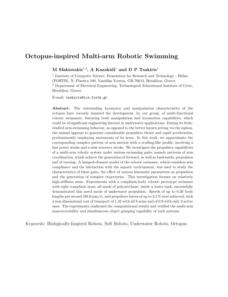

Date of publication: 2015
Authors: Francesco Giorgio-Serchi, Federico Renda,
and Cecilia Laschi
Cephalopods are being used as a source of inspiration for
the development of a new type of underwater soft robot.
These cephalopod-inspired, soft-bodied vehicles entail a
hollow, elastic shell capable of performing a routine of
recursive ingestion and expulsion of discrete slugs of fluids
through the actual inflation and deflation of the elastic
chamber.
.

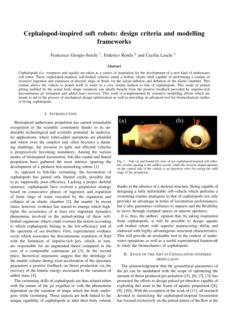

Authors: Michael Beckert, Brooke E. Flammang and
Jason H. Nadler
Remora fish are capable of adhering to a wide variety of
natural and artificial marine substrates using a dorsal
suction pad. The pad is made of serial parallel pectinated
lamellae, which are homologous to the dorsal fin
elements of other fish.
In this work, the geometry of the spinules and host
topology, as determined by micro-computed tomography
and confocal microscope data, respectively, are combined
in a friction model to estimate the spinules' contribution to
shear resistance.

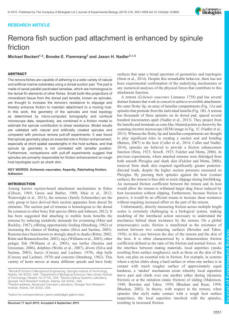

Date of publication: 2015
Authors: Mohsen Asadnia, Ajay Giri Prakash Kottapalli,
Jianmin Miao, Majid Ebrahimi Warkiani, and
Michael S. Triantafyllou
Using biological sensors, aquatic animals like fish are
capable of performing impressive behaviors, such as
super-maneuverability, hydrodynamic flow “vision," and
object localization with a success unmatched by human-
engineered technologies. Inspired by the multiple
functionalities of the ubiquitous lateral-line sensors of fish,
the authors have developed flexible and surface-
mountable arrays of icroelectromechanical systems
(MEMS) artificial hair cell flow sensors.

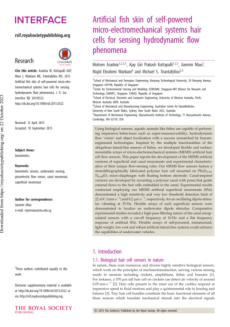

Date of publication: 2015
Authors: F. Renda, F. Giorgio-Serchi, F. Boyer, C. Laschi
Cephalopods are being looked upon as a source of
inspiration for the development of unmanned underwater
vehicles. One kind of cephalopod-inspired, soft-bodied
vehicle developed by the authors entails a hollow, elastic
shell capable of performing a routine of recursive
ingestion and expulsion of discrete slugs of fluids which
enable the vehicle to propel itself in water. The vehicle
performances were found to depend largely on the elastic
response of the shell to the actuation cycle, thus
motivating the development of a coupled propulsion-
elastodynamics model of such vehicles.

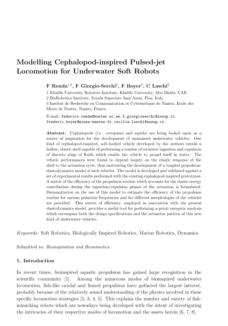

Date of publication: 2015
Authors: Satja Sivcev, Joseph Coleman, David Adley,
Gerard Dooly, Edin Omerdic, Daniel Toal
Underwater robot manipulators mounted on work-class
ROVs are extensively used in a wide range of subsea
intervention applications. Unlike the automated stationary
robot arms used in factories, commercial underwater
manipulators are teleoperated by a human pilot in the
loop. The authors describe the investigation, and
adaptation of robot manipulator servo control approaches
commonly used for light assembly tasks in the industry
and the transfer of these techniques to marine robotics.

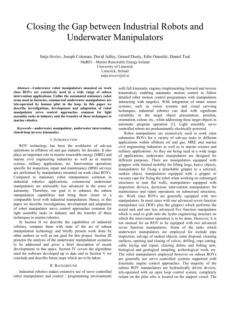

Date of publication: 2016
Authors: John B. Potts
An anguilliform swimming robot replicating an idealized
motion is a complex marine vehicle that requires
theoretical and experimental analysis to completely
understand its propulsion characteristics. The ideal
anguilliform motion is theorized to produce “wakeless”
swimming within. This reactive swimming technique
thrusts by accelerating the added mass near the body. The
net circulation for the unsteady motion is theorized to be
eliminated. The robot was designed to replicate the
desired theoretical motion using control theory methods.
Independent joint control was used due to hardware
limitations.

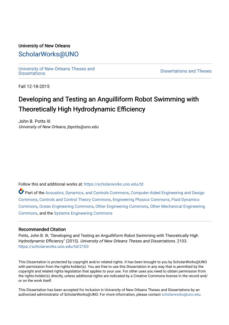

Date of publication: 2016
Authors: Supun A. T. Randeni, Alexander L. Forrest,
Remo Cossu, and Zhi Quan Leong. Peter D.
King, Dev Ranmuthugala
This study analyzes the feasibility of incorporating a non-
acoustic method to calculate the water velocity this
method within the navigation system by investigating its
accuracy at different turbulence levels of the water
column.

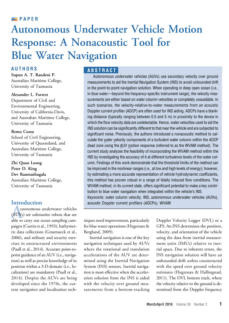

Authors:
Kevin C. Galloway, Kaitlyn P. Becker, Brennan Phillips,
Jordan Kirby, Stephen Licht, Dan Tchernov, Robert
J. Wood and David F. Gruber
This article presents the development of an underwater
gripper that utilizes soft robotics technology to delicately
manipulate and sample fragile species on the deep reef.
Existing solutions for deep-sea robotic manipulation have
historically been driven by the oil industry, resulting in
destructive interactions with undersea life. Soft material
robotics relies on compliant materials that are inherently
impedance-matched to natural environments and to soft
or fragile organisms.



Authors: Anil Antony Sequeira, Afeef Usman,
Oommen Philip Tharakan, Mir Zeshan Ali
This paper presents the state of art survey and future work
to biologically inspired robots. Through decades people
have constantly tried to emulate the appearance,
portability, usefulness, astute operation, and intellect of
fauna.
This area of biological robots, having the name of
biomimetics, has advanced from making stationary
duplicates of human beings and other biological
creatures as statues to the rise of robots that work with
practical conduct.

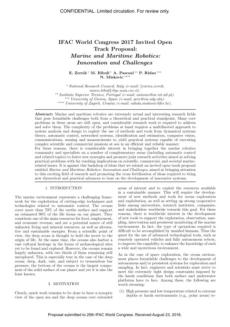

Authors: E. Zereik, M. Bibuli, A. Pascoal, P. Ridao, and N.
Miskovic
Marine and maritime robotics are extremely actual and
interesting research fields that pose formidable challenges
both from a theoretical and practical standpoint. The
complexity of the problems at hand requires a
multifaceted approach to system analysis and design to
exploit the use of methods and tools from dynamical
systems theory, automatic control, networked systems,
identification and estimation, computer vision,
communications, sensing and measurements to yield
practical systems capable of executing complex scientific
and commercial missions at sea in an efficient and reliable
manner.



Authors:
Sung-Jin Park, Mattia Gazzola, Kyung Soo Park, Shirley Park,
Valentina Di Santo, Erin L. Blevins, Johan U. Lind,
Patrick H. Campbell, Stephanie Dauth.
Andrew K. Capulli, Francesco S. Pasqualini, Seungkuk Ahn,
Alexander Cho, Hongyan Yuan, Ben M. Maoz, Ragu
Vijaykumar, Jeong-Woo Choi, Karl Deisseroth, and
George V. Lauder, L. Mahadevan, Kevin Kit Parker
Inspired by the relatively simple morphological blueprint
provided by batoid fish such as stingrays and skates, the
authors created a biohybrid system that enables an
artificial animal, a tissue-engineered ray, to swim and
phototactically follow a light cue.

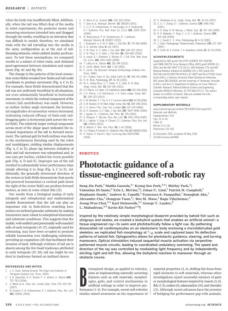

Date of publication: 2016
Authors: Guijie Liu, Anyi Wang, Xinbao Wang, and
Peng Liu
Lateral line is a system of sense organs that can aid fishes
to maneuver in a dark environment. Artificial lateral line
(ALL) imitates the structure of lateral line in fishes and
provides invaluable means for underwater-sensing
technology and robot fish control. This paper reviews ALL,
including sensor fabrication and applications to robot fish.



Date of publication: 2016
Author: Ramos García, Néstor; Sarlak Chivaee, Hamid
Andersen, Søren Juhl Sørensen, Jens Nørkær
In the present work, an in-house Unsteady Double Wake
Model (USDWM) has been developed to simulate general
flow problems behind bodies. The model is presented and
used to simulate flows past a circular cylinder at subcritical,
supercritical, and transcritical flows. The flow model is a
two-dimensional panel method that uses the unsteady
double wake technique to model flow separation and its
dynamics. In the present work, the separation location is
obtained from experimental data and fixed in time.

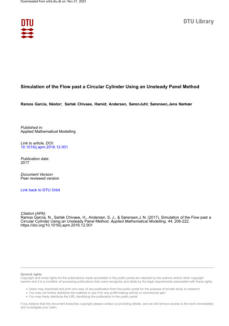

Authors:
Tiefeng Li, Guorui Li, Yiming Liang, Tingyu Cheng, Jing
Dai, Xuxu Yang, Bangyuan Liu, Zedong Zeng,
Zhilong Huang, Yingwu Luo, Tao Xie, and Wei
Yang
Soft robots driven by stimuli-responsive materials have
unique advantages over conventional rigid robots,
especially in their high adaptability for field exploration
and seamless interaction with humans. The challenge lies
in achieving self-powered soft robots with high mobility,
environmental tolerance, and long endurance. The
authors describe a soft electronic fish with a fully-
integrated onboard system for power and remote control.
.

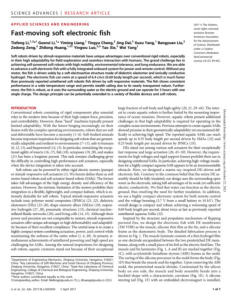

Authors: Yonggang Jiang, Zhiqiang Ma, Jianchao Fu,
and Deyuan Zhang
Surface mounted “smart skin” can enhance the situational
and environmental awareness of marine vehicles, which
requires flexible, reliable, and lightweight hydrodynamic
pressure sensors. Inspired by the lateral line canal system in
fish, the authors developed an artificial lateral line (ALL)
canal system by integrating cantilevered flow-sensing
elements into a polydimethylsiloxane (PDMS) canal.
Polypropylene and polyvinylidene fluoride (PVDF) layers
were laminated together to form the cantilevered flow-
sensing elements.

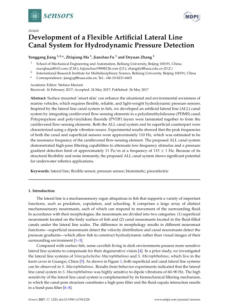

Authors: Asimina Kazakidi, Dimitris P. Tsakiris, John A.
Ekaterinaris
This paper explores the impact of bio-inspired arm
morphology on underwater propulsion through an
examination of the hydrodynamic forces generated and
the corresponding complex vortical patterns in the wake
of a novel two-arm underwater robotic swimmer inspired
by the octopus' arm-swimming behavior.

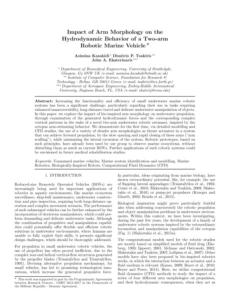

Authors: Shuming Wang, Pin Chieh Wu, Vin-Cent Su,
Yi-Chieh Lai, Cheng Hung Chu, Jia-Wern
Chen, Shen-Hung Lu, Ji Chen, Beibei Xu,
Chieh-Hsiung Kuan, Tao Li, Shining Zhu, and
Din Ping Tsai.
Due to the high phase dispersion of their building blocks,
metasurfaces significantly suffer from large chromatic
aberration. The authors propose a design principle to
realize achromatic metasurface devices that successfully
eliminate chromatic aberration over a continuous
wavelength region from 1200 to 1680 nm for circularly-
polarized incidences in a reflection scheme.

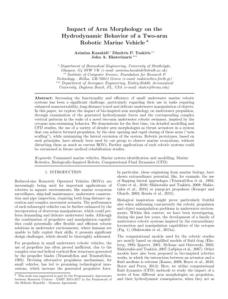

Authors: Jun Shintake, Vito Cacucciolo, Herbert Shea,
and Dario Floreano
This article presents the design, fabrication, and
characterization of a soft biomimetic robotic fish based on
dielectric elastomer actuators (DEAs) that swims by body
and/or caudal fin (BCF) propulsion. BCF is a promising
locomotion mechanism that potentially offers swimming
at higher speeds and acceleration rates, and efficient
locomotion. The robot consists of laminated silicone layers,
in which two DEAs are used in an antagonistic
configuration, generating undulating fish-like motion.



Authors:
Yueping Wang, Xingbang Yang, Yufeng Chen, Dylan K.
Wainwright, Christopher P. Kenaley, Zheyuan Gong,
Zemin Liu, Huan Liu, Juan Guan, Tianmiao Wang, James
C. Weaver, Robert J. Wood, Li Wen
The authors present the design of a biologically
analogous, multimaterial biomimetic remora disc based on
detailed morphological and kinematic investigations of the
slender sharksucker.




Date of publication: 2017
Authors: Supun Anuradhitha Tilakeratne Randeni
Pathiranachchilage
The objective of this thesis is to contribute to Autonomous
Underwater Vehicle (AUV) navigation by improving
vehicle localization accuracy when Doppler Velocity Log
(DVL) bottom-tracking is unavailable.



Date of publication: 2017
Authors: J. Sverdrup-Thygeson, E. Kelasidi, K. Y.
Pettersen, and J. T. Gravdahl
The underwater swimming manipulator (USM)
presented in this paper is an innovative, bio-inspired
addition to the family of underwater robotic vehicles.
The overall vision of the USM is to impact how
inspection and light intervention tasks are performed
significantly. In this paper, the authors discuss the most
important applications of the USM and the main
challenges related to modeling, guidance, and control
of this innovative vehicle.





Click on the
octopus to return to
the top of the page

Authors: Josie Hughes, Utku Culha, Fabio Giardina, Fabian
Guenther, Andre Rosendo, and Fumiya Iida
This paper evaluates the materials,processes, actuation
methods, and sensors used in the development of soft
manipulators. The achievements and shortcomings of
recent technology in these key areas are evaluated, and
the paper concludes with a discussion of the potential
impact of soft manipulators on industry and society.
on industry and society.



Authors: Thomas George Thuruthel, Egidio Falotico,
Federico Renda, and Cecilia Laschi
This paper presents a machine learning-based approach
for developing dynamic models for a soft robotic
manipulator and a trajectory optimization method for
predictive task space control of the manipulator. To the
best of our knowledge, this is the first demonstration of a
learned dynamic model and a derived task space
controller for a soft robotic manipulator. The validation of
the controller is performed on an octopus-inspired soft
manipulator simulation, derived from a piecewise constant
strain approximation.

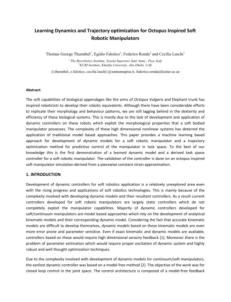

Date of publication: 2017
Authors: MD Moniruzzaman, Syed Mohammed Shamsul
Islam, Mohammed Bennamoun, Paul Lavery
This paper systematically describes the use of deep
learning for underwater image analysis in the recent past.
The analysis approaches are categorised according to the
object of detection, and the features and deep learning
architectures used are highlighted. It is
is concluded that there is a great potential for automation
in the analysis of digital seabed imagery using deep neural
networks, especially for seagrass detection and
monitoring.

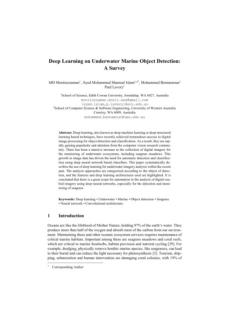



Authors: Margarida Pedro, David Moreno-Salinas, N.
Crasta, Antonio Pascoal
This paper addresses the challenges and methodologies
involved in range-based marine vehicle positioning and
target localization. Its aim is to provide guidelines for
estimating marine vehicle positions using range
measurements from acoustic beacons, develop vehicle
trajectories that maximize the information available for
positioning while avoiding collisions and adhering to
maneuvering constraints, and propose numerical and
analytical solutions for vehicle positioning and target
localization.

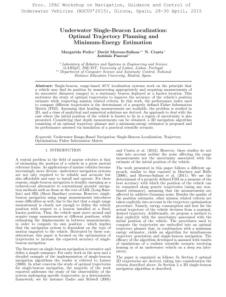

Authors: D. Moreno-Salinas, N. Crasta, M. Ribeiro, B. Bayat,
A. M. Pascoal, J. Aranda
This paper intends to describe a study on improving the
accuracy of Autonomous Underwater Vehicle (AUV)
localization systems using single-beacon, range-based
methods. The study focuses on developing optimal
trajectories for the AUV to enhance position estimates
while meeting mission criteria. It introduces the use of the
Fisher Information Matrix (FIM) as a performance index for
comparing different trajectories. The research includes 2D
and 3D navigation algorithms, addressing scenarios
where the vehicle's initial position is uncertain, and
incorporating depth measurements for 3D navigation.



Authors:
Anko Börner, Dirk Baumbach, Maximilian Buder, Andre
Choinowski, Ines Ernst, Eugen Funk, Denis Grießbach,
Adrian Schischmanow, Jürgen Wohlfeil and Sergey Zuev
This study introduces and describes a new multi-sensor
system developed by the German Aerospace Center (DLR)
for ego localization, called the integrated positioning
system (IPS). It explains the importance of ego localization
for various tasks, the challenges faced when satellite-based
navigation is unavailable, and how the IPS addresses these
challenges. It also outlines the system's components, real-
time operational capabilities, and the development
process of this technology into a commercial product.
.

